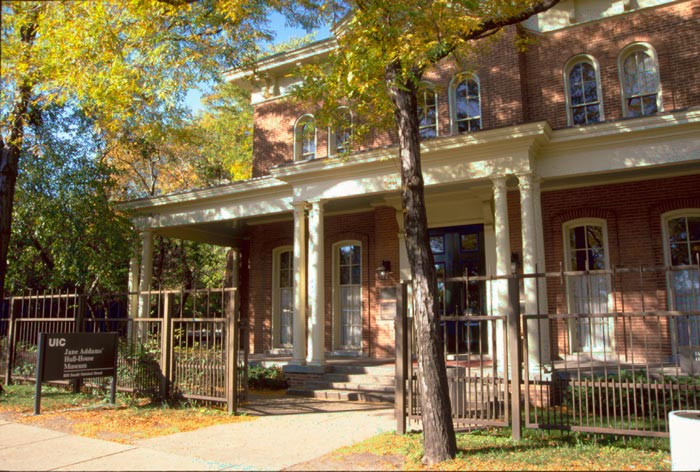Photography by Lauren Meranda
Unfinished Business: 21st Century Home Economics is a new exhibit at the Jane Addams Hull-House Museum charting the histories and present day stories of domestic workers and home economists. Through participatory experiences, activities, and multimedia installations, the exhibit invites viewers to not only recognize progress made by previous generations but also identify the areas within the movement where additional progress is needed today. The museum collaborated on the exhibit with multiple area artists and organizers including the Chicago Coalition of Household Workers, Frau Fiber, the Chicago Childcare Collective, the Academy for Global Citizenship, the Center for Urban Economic Development at UIC, Street Level Youth Media, and the Collective Cleaners. Gozamos was in attendance during the opening reception in December to interview collaborators and report on the exhibition.

Real Work and Real Workers
Lisa Thomas, a household worker organizer with the Latino Union of Chicago and Chicago Coalition of Household Workers, has over 21 years of experience as a domestic caregiver to the elderly. When asked about what she would like to see happen as a result of increased awareness to domestic labor working conditions brought about by local activist organizations and collaborative projects like Unfinished Business, Lisa says: “I just wish that things could change. That people can see this as real work and that these women and myself can be appreciated for the work we do.”
A truth voiced by many community organizers and advocates, the work done by women like Lisa is the work that allows all other work to be done. Nannies, caregivers, and housecleaners tend to the needs of children, the elderly and disabled, and households thereby freeing others within those households to go about their day unencumbered; allowing those individuals to work and earn. Yet, despite the critical function of domestic workers in our homes and economy, domestic workers in this country still lack standard protections afforded to other laborers. Elements on display in Unfinished Business: 21st Century Home Economics detail the state of domestic labor today both in personal and empirical terms.
The Work Yet To Be Done
Displayed in the Unfinished Business exhibit are domestic workers’ personal artifacts, and their startlingly honest narrative describes conditions that range from mildly uncomfortable to criminally abusive. Empirical validation that these conditions may represent the norm as opposed to the exception is also housed within the exhibit in the form of archives from a recently published groundbreaking national survey of domestic workers titled, Home Economics: The Invisible and Unregulated World of Domestic Work. According to the study, which was undertaken by the National Domestic Workers Alliance, DataCenter and Center for the Urban Economic Development at UIC, nearly a quarter of domestic caregivers are paid below minimum wage and about two-thirds of all domestic caregivers lack health insurance. Additionally, a majority of all domestic workers spend more than half their income on rent (60%), claim to have been injured on the job (64%), and indicate they’ve reported to work despite being injured or sick (66%). Those figures are higher for undocumented workers in comparison to both U.S. born and documented workers.
Community activist and household worker organizer, Myrla Baldonado was also in attendance during opening night. According to Myrla, one of the main ways concerned individuals could advocate for domestic workers is by supporting and getting the word out about the Domestic Worker Bill of Rights (as many domestic workers are excluded from the federal Fair Labor Standards Act). Passing legislation like the Domestic Worker Bill of Rights in Illinois would go a long way toward providing worker protections and fair wages, at least at the state level. Also, Myrla believes change can come from people learning to become better, kinder employers to their caregivers even without the law mandating it.

Then and Now
In addition to domestic labor, the exhibit also features multiple interactive installations on food and hunger, childcare, and craft and conscientious consumption. An audio station profile of a cafeteria worker at the Academy for Global Citizenship tells of current innovation in school lunch preparation and cooking. A history of childcare captured on children’s toy blocks provides a family friendly hands-on experience. One installation allows participants to use sewing machines from the early 1900s in the upcycling of used t-shirts into tote bags.
Among the historical artifacts on display are items from Mary Keyser, Jane Addam’s housekeeper. Keyser arrived from Addam’s family home at the Hull-House in 1889 and stayed there to serve as a caretaker at the settlement. In reference to an iron on display from Keyser, Myrla Baldonado shared: “Hers [Keyser] was the work that made things possible for Jane Addams. Yes, Jane Addams was brilliant, but imagine Jane Addams ironing her own clothes. Doing her own laundry -so long ago in the past. No washing machine! Could you imagine? I couldn’t imagine.”
About the Museum
On south Halsted at the UIC campus, the Jane Addams Hull-House Museum commemorates the original Hull-House settlement (1889-1963) founded by Jane Addams and her colleague, Ellen Gates Starr. The reform and advocacy work of Addams and her colleagues at the Hull-House impacted the lives of neighboring immigrant populations at the settlement location in Chicago and those of workers and immigrants nationwide. Addams was the first American woman recipient of the Nobel Peace Prize.
Unfinished Business: 21st Century Home Economics
Exhibit runs through August 2013
Cost: Free
Location: Jane Addams Hull-House Museum, 800 S Halsted, Chicago IL
Museum Hours: Tuesdays-Fridays: 10am to 4pm and Sunday: Noon to 4pm
Contact number: 312.413.5353
If you are an upcoming College student who will be taking the Advanced Placement test in Macroeconomics, then best to check for online resources to help you find the AP Macroeconomics prep books for your needs.
